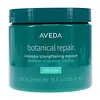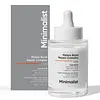What's inside
What's inside
 Key Ingredients
Key Ingredients

 Benefits
Benefits

 Concerns
Concerns

 Ingredients Side-by-side
Ingredients Side-by-side

Water
Skin ConditioningCetearyl Alcohol
EmollientStearamidopropyl Dimethylamine
EmulsifyingBehentrimonium Methosulfate
Dicetyldimonium Chloride
EmulsifyingPersea Gratissima Oil
Skin ConditioningPlukenetia Volubilis Seed Oil
EmollientCamellia Oleifera Seed Oil
Skin ConditioningButyrospermum Parkii Butter
Skin ConditioningCocos Nucifera Oil
MaskingHelianthus Annuus Seed Oil
EmollientEuphorbia Cerifera Wax
Behenyl/Octyldodecyl Propanediol Citrate Crosspolymer
Skin ConditioningOctyldodecyl Citrate Crosspolymer
HumectantHydroxypropylammonium Gluconate
HumectantHydroxypropylgluconamide
HumectantIsostearyl Ethylimidazolinium Ethosulfate
Tocopherol
AntioxidantPropanediol
SolventLactic Acid
BufferingTricaprylyl Citrate
EmollientHeptyl Undecylenate
EmollientCetyl Hydroxyethylcellulose
Emulsion StabilisingSqualane
EmollientIsopropyl Alcohol
SolventCetrimonium Chloride
AntimicrobialParfum
MaskingAmyl Cinnamal
PerfumingCitral
PerfumingGeraniol
PerfumingCitronellol
PerfumingBenzyl Salicylate
PerfumingBenzyl Benzoate
AntimicrobialLinalool
PerfumingHydroxycitronellal
PerfumingLimonene
PerfumingBenzyl Alcohol
PerfumingTartaric Acid
BufferingSodium Benzoate
MaskingCaprylyl Glycol
EmollientPotassium Sorbate
PreservativePhenoxyethanol
PreservativeWater, Cetearyl Alcohol, Stearamidopropyl Dimethylamine, Behentrimonium Methosulfate, Dicetyldimonium Chloride, Persea Gratissima Oil, Plukenetia Volubilis Seed Oil, Camellia Oleifera Seed Oil, Butyrospermum Parkii Butter, Cocos Nucifera Oil, Helianthus Annuus Seed Oil, Euphorbia Cerifera Wax, Behenyl/Octyldodecyl Propanediol Citrate Crosspolymer, Octyldodecyl Citrate Crosspolymer, Hydroxypropylammonium Gluconate, Hydroxypropylgluconamide, Isostearyl Ethylimidazolinium Ethosulfate, Tocopherol, Propanediol, Lactic Acid, Tricaprylyl Citrate, Heptyl Undecylenate, Cetyl Hydroxyethylcellulose, Squalane, Isopropyl Alcohol, Cetrimonium Chloride, Parfum, Amyl Cinnamal, Citral, Geraniol, Citronellol, Benzyl Salicylate, Benzyl Benzoate, Linalool, Hydroxycitronellal, Limonene, Benzyl Alcohol, Tartaric Acid, Sodium Benzoate, Caprylyl Glycol, Potassium Sorbate, Phenoxyethanol
Caprylic/Capric Triglyceride
MaskingCocos Nucifera Oil
MaskingIsoamyl Laurate
EmollientPentylene Glycol
Skin ConditioningMaleic Acid
Buffering2-Tert-Butylcyclohexanol
PerfumingArgania Spinosa Kernel Oil
EmollientSqualane
EmollientGlycine Soja Hull
AbrasiveZea Mays Oil
EmulsifyingCysteine
AntioxidantLeucine
Skin ConditioningIsoleucine
Skin ConditioningPhenylalanine
MaskingArginine
MaskingTransglutaminase
Skin ConditioningDaucus Carota Sativa Root Extract
Skin ConditioningTocopherol
AntioxidantParfum
MaskingBHT
AntioxidantCaprylic/Capric Triglyceride, Cocos Nucifera Oil, Isoamyl Laurate, Pentylene Glycol, Maleic Acid, 2-Tert-Butylcyclohexanol, Argania Spinosa Kernel Oil, Squalane, Glycine Soja Hull, Zea Mays Oil, Cysteine, Leucine, Isoleucine, Phenylalanine, Arginine, Transglutaminase, Daucus Carota Sativa Root Extract, Tocopherol, Parfum, BHT
Ingredients Explained
These ingredients are found in both products.
Ingredients higher up in an ingredient list are typically present in a larger amount.
Cocos Nucifera Oil is obtained from the kernels of the coconut fruit. In other words, this is coconut oil.
Coconut Oil is rich in fatty acids with lauric acid making up the majority of these. It also contains linoleic acid. Due to this high fatty acid content, coconut oil helps trap moisture and soften skin.
Despite being antibacterial, coconut oil may not be great for acne-prone skin. It is comedogenic and may clog pores. This ingredient may not be safe for malassezia or fungal acne.
Note: Coconut Oil should not replace your sunscreen for UV protection. Studies show it only blocks about 20% of UV.
This oil is non-volatile and has a light scent.
The term 'fragrance' is not regulated in many countries. In many cases, it is up to the brand to define this term. For instance, many brands choose to label themselves as "fragrance-free" because they are not using synthetic fragrances. However, their products may still contain ingredients such as essential oils that are considered a fragrance.
Learn more about Cocos Nucifera OilParfum is a catch-all term for an ingredient or more that is used to give a scent to products.
Also called "fragrance", this ingredient can be a blend of hundreds of chemicals or plant oils. This means every product with "fragrance" or "parfum" in the ingredients list is a different mixture.
For instance, Habanolide is a proprietary trade name for a specific aroma chemical. When used as a fragrance ingredient in cosmetics, most aroma chemicals fall under the broad labeling category of “FRAGRANCE” or “PARFUM” according to EU and US regulations.
The term 'parfum' or 'fragrance' is not regulated in many countries. In many cases, it is up to the brand to define this term.
For instance, many brands choose to label themselves as "fragrance-free" because they are not using synthetic fragrances. However, their products may still contain ingredients such as essential oils that are considered a fragrance by INCI standards.
One example is Calendula flower extract. Calendula is an essential oil that still imparts a scent or 'fragrance'.
Depending on the blend, the ingredients in the mixture can cause allergies and sensitivities on the skin. Some ingredients that are known EU allergens include linalool and citronellol.
Parfum can also be used to mask or cover an unpleasant scent.
The bottom line is: not all fragrances/parfum/ingredients are created equally. If you are worried about fragrances, we recommend taking a closer look at an ingredient. And of course, we always recommend speaking with a professional.
Learn more about ParfumSqualane is an emollient that helps the skin hold onto moisture. It's an oily liquid that occurs naturally in certain types of fish and plant oils.
Because squalane boosts hydration in the skin, it also comes with plenty of benefits: it is an antioxidant and can help fight free radicals and skin damage. Squalane is also found to have a detoxifying effect when applied.
Squalane comes from squalene, which occurs naturally within the sebum of our skin. It is one of the oils our skin produces to keep itself hydrated. Squalane is the hydrogenated version of squalene and has a longer shelf life.
Research shows that squalane is non-irritating (even at 100% concentration).
In general, it's a fantastic ingredient. It does a great job at hydrating the skin, and it's suitable for those with sensitive skin.
The source of squalane may impact malassezia / fungal acne. This is because olive oil derived squalane can contain impurities such as fatty acids and plant waxes. Sugarcane derived squalane is recommended for anyone with malassezia concerns.
Is squalane vegan?
This depends on the source. Squalane can be derived from both plants and animals. Most squalane used in skincare comes from plants.
Please note: the source of squalane is only known if disclosed by the brand. We recommend reaching out to the brand if you have any questions about their squalane.
Read more about squalene with an "e".
Is squalane an oil?
Squalane is often called an oil, but it’s technically not; it’s a hydrocarbon, meaning it’s only made of carbon and hydrogen, unlike true oils which are triglycerides made of fatty acids and glycerol.
The term “oil-free” isn’t regulated, so companies can define it however they want. Some exclude all oils, while others just avoid mineral oil or comedogenic oils.
While some people avoid oils thinking they cause breakouts, the right kind of oil (or oil-like ingredient like squalane) can actually help balance and hydrate your skin. It’s worth testing out simple oils or squalane to see what works best for your skin.
Learn more about SqualaneTocopherol (also known as Vitamin E) is a common antioxidant used to help protect the skin from free-radicals and strengthen the skin barrier. It's also fat soluble - this means our skin is great at absorbing it.
Vitamin E also helps keep your natural skin lipids healthy. Your lipid skin barrier naturally consists of lipids, ceramides, and fatty acids. Vitamin E offers extra protection for your skin’s lipid barrier, keeping your skin healthy and nourished.
Another benefit is a bit of UV protection. Vitamin E helps reduce the damage caused by UVB rays. (It should not replace your sunscreen). Combining it with Vitamin C can decrease sunburned cells and hyperpigmentation after UV exposure.
You might have noticed Vitamin E + C often paired together. This is because it is great at stabilizing Vitamin C. Using the two together helps increase the effectiveness of both ingredients.
There are often claims that Vitamin E can reduce/prevent scarring, but these claims haven't been confirmed by scientific research.
Learn more about Tocopherol